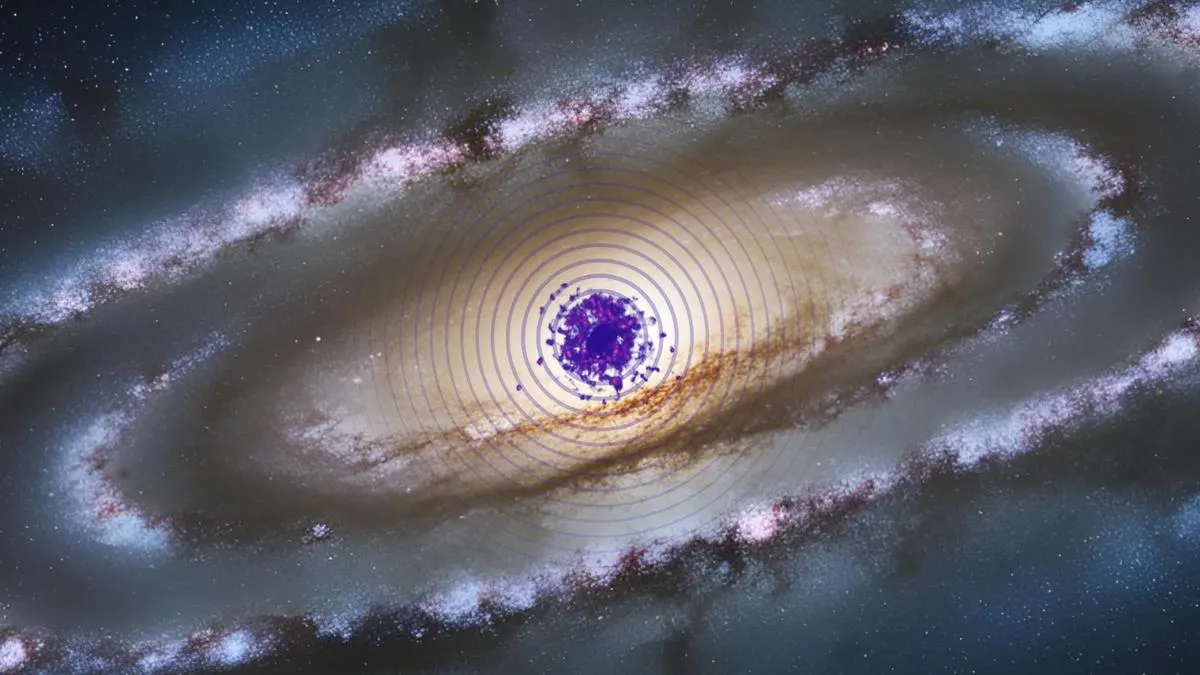
Recent observations of unusual phenomena at the very center of the Milky Way galaxy may serve as compelling evidence for a new candidate in the ongoing search for dark matter. This elusive substance is believed to constitute approximately 85% of the universe's mass, yet remains largely undetectable through conventional means. Scientists now propose that the subtle impacts of dark matter may be influencing cosmic chemistry, particularly in the region known as the Central Molecular Zone (CMZ).
The newly proposed dark matter candidate is intriguing for several reasons. Unlike existing hypothetical particles, this candidate is not only lighter than a proton but also possesses the unique ability to self-annihilate. When two of these dark matter particles collide, they annihilate each other, resulting in the creation of a negatively charged electron and its positively charged counterpart, a positron. This annihilation process, along with the subsequent flood of electrons and positrons, can strip electrons from neutral atoms, leading to a phenomenon known as ionization.
The central region of the Milky Way, known as the CMZ, exhibits an abundance of ionized gas. The proposed dark matter candidate could explain this phenomenon by contributing to the ionization process. As dark matter particles annihilate into electron-positron pairs, these pairs interact with the surrounding gas, resulting in significant ionization. According to Shyam Balaji, the team leader and Postdoctoral Research Fellow at King’s College London, this process might reveal dark matter's presence in a manner distinct from traditional gravitational effects.
Currently, dark matter is theorized to exist due to its gravitational influence on visible matter, light, and the structure of the universe. However, it does not interact with light in a way that would make it visible, setting it apart from ordinary matter composed of protons, neutrons, and electrons. This has led researchers to explore beyond the standard model of particle physics, searching for other particles that could account for dark matter.
Prominent candidates for dark matter include axions and axion-like particles, which vary in mass and characteristics. However, Balaji and his team have ruled out these candidates as responsible for the ionization seen in the CMZ. Most axion models do not predict significant annihilation into electron-positron pairs, which is a key feature of the newly proposed dark matter particle.
The proposed dark matter candidate is described as sub-GeV in mass, meaning it is lighter than many other dark matter suspects. This characteristic allows it to directly influence the interstellar medium, resulting in unique signatures of ionization that are not associated with axion models. In the densely packed CMZ, created positrons cannot travel far before interacting with nearby hydrogen molecules, making the ionization process particularly efficient in this central region.
A primary challenge for dark matter research has been explaining the observed excess of ionization in the CMZ. Traditional theories attribute ionization to cosmic rays, high-energy charged particles that travel near the speed of light. However, Balaji's research indicates that cosmic rays alone cannot account for the high levels of ionization observed, particularly since there is no corresponding gamma-ray emission typically expected from such interactions.
Interestingly, there is a faint gamma-ray glow emanating from the Galactic Center that may also be linked to positrons and ionization processes. If a direct connection between ionization and gamma-ray emissions is established, it could further support the dark matter hypothesis. Balaji emphasizes the need for more data to strengthen this correlation, which could revolutionize our understanding of dark matter.
Despite being in the early stages of theoretical development, this new dark matter candidate offers a fresh perspective on the influence of dark matter in the universe. The absence of a catchy name like WIMP (Weakly Interacting Massive Particle) or MACHO (MAssive Compact Halo Object) reflects the nascent state of this research. To advance the study, Balaji suggests the need for precise measurements of ionization within the CMZ, which could help identify whether it aligns with the expected distribution of dark matter.
Future missions, such as NASA’s upcoming COSI (Compton Spectrometer and Imager) gamma-ray space telescope, set to launch in 2027, may provide critical data regarding astrophysical processes at the MeV (1 million eV) scale. This could be instrumental in confirming or ruling out the proposed dark matter explanation. Regardless of the outcome, this research paves the way for a deeper understanding of the universe's most enigmatic substance, dark matter.